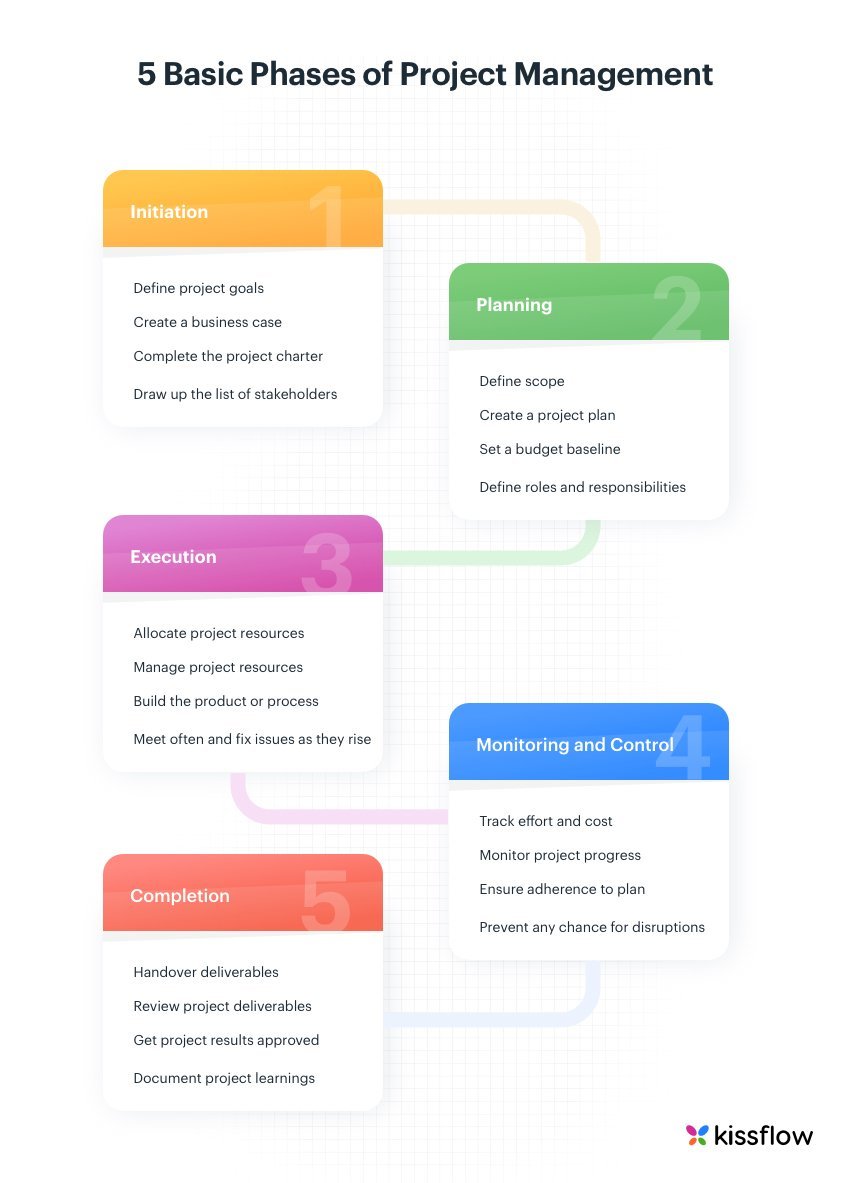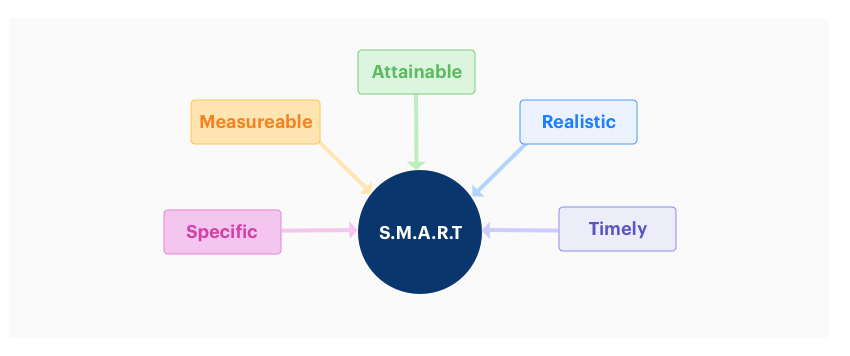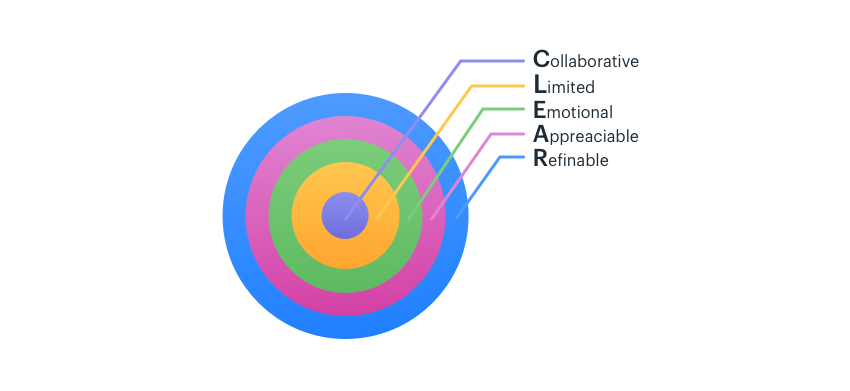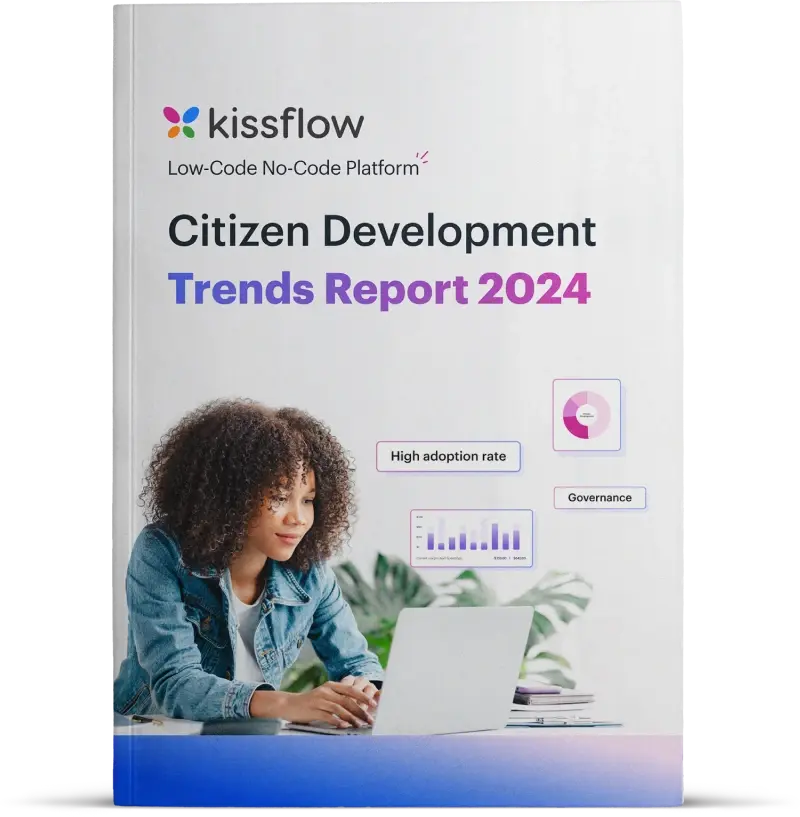Managing a project is no easy feat, no matter what the scale and scope are. From planning the minutia to handling the ever-changing demands of clients to shipping the deliverables on time, there’s a lot that can go wrong. When you divide the project into manageable stages, each with its own goals and deliverables, it’s easier to control the project and the quality of the output.
In a project management guide, if you are somehow in a position where you are expected to manage projects for your organization and are feeling overwhelmed, it’s better to start learning the basic stages of the project life cycle phases.
According to the PMBOK Guide (Project Management Body of Knowledge) by the Project Management Institute (PMI), a project management life cycle consists of 5 distinct phases including initiation, planning, execution, monitoring, and closure that combine to turn a project idea into a working product.

Five phases of project management
The 5 basic phases in the project management process are:
- Project Initiation
- Project Planning
- Project Execution
- Project Monitoring and Controlling
- Project Closing

Phase 1: Project initiation
The project initiation phase is the first stage of turning an abstract idea into a meaningful goal. In this stage, you need to develop a business case and define the project on a broad level. In order to do that, you have to determine the need for the project and create a project charter.
The project charter is an important document consisting of details like the project constraints, goals, appointment of the project manager, budget, expected timeline, etc. Project managers can utilize background removal tools to create clean, professional-looking project visuals and presentations.
Once you have the project goals and project scope, identify key project stakeholders–the people who are to be involved in the project. Create a stakeholder register with the roles, designation, communication requirements, and influence.
While a clear goal of the project is established in this phase, a project charter does not contain any technical details that happen in the planning stage.
Consider the example of an automobile manufacturer assigned to develop an electric vehicle. The selection of the design, capacity, and battery power of the vehicle will not be a part of the initiation phase. The only certainty would be that an electric vehicle will be developed within the given timeframe and budget.
See how Kissflow delivers the fastest time-to-value in the market
Phase 2: Project planning
The project planning stage requires complete diligence as it lays out the project’s roadmap. Unless you are using a modern project management methodology like agile project management, the second phase of project management is expected to take almost half of the entire project’s timespan.
Schedule Your Personalized Free Demo for Kissflow Low-Code Platform
In this phase, the primary tasks are identifying technical requirements, developing a detailed project schedule, creating a communication plan, and setting up goals/deliverables. Some examples of web applications include shopping carts, online forms, spreadsheets, word processors, PDF file conversion programs, video and photo editing software, file scanning tools, and email programs such as Gmail and Yahoo.
There are several methods of setting up the project’s goals but S.M.A.R.T. and C.L.E.A.R. are the most popular.

Want to learn project management but put off by jargon?
Learn what's important in the simplest ebook for non-project managers.
Download NowS.M.A.R.T Goals:
The ‘SMART’ criteria ensure that the goals you set for your project are critically analyzed. It is an established method that reduces risk and allows project managers to make clearly defined and achievable goals.
The acronym SMART stands for
C.L.E.A.R. Goals:
The ‘CLEAR’ method of setting up goals is designed to cater to the dynamic nature of a modern workplace. Today’s fast-paced businesses require flexibility and immediate results and CLEAR can help citizen developers with that.
The acronym for CLEAR stands for

During the planning stage, the scope of the project is defined. There is a possibility of changing the scope of the project demands it but the project manager must approve the change. Project managers also develop a work breakdown structure (WBS), which clearly visualizes the entire project in different sections for the team management.
Learn more about how project goals and objectives are defined.
A detailed project timeline with each deliverable is another important element of the planning stage. Using that timeline, project managers can develop a project communication plan and a schedule of communication with the relevant stakeholders.
Risk mitigation is another important aspect of project management that is a part of the planning stage. The project manager is responsible for extrapolating past data to identify potential project management risks and develop a strategy to minimize them.
An important element that professionals often overlook is an effective change management plan. As a project manager, you must be ready to incorporate a few changes in the project to avoid bottlenecks and project delays.
In the absence of a working change management plan, scope creep happens and causes huge problems for the project team in the later stages of the project. So, it’s best to reduce the possibility of unforeseen changes as much as possible.
And don’t forget to try our Free and Customizable Templates:
– Content Calendar Template for Strategic Content Planning
– Competitive Analysis Template for Strategic Content Planning
Phase 3: Project execution
The project execution stage is where your team does the actual work. As a project manager, your job is to establish efficient workflows and carefully monitor the progress of your team.
Another responsibility of the project manager during this phase is to consistently maintain effective collaboration between project stakeholders. This ensures that everyone stays on the same page and the project runs smoothly without any issues.
You can take help from the best project collaboration tools that are available in the market. They’ll not only make your life easier but also improve efficiency and increase the productivity of your team.
Utilizing a brainstorming tool can be transformative in enhancing team collaboration and brainstorming. This app allows team members to visualize ideas, share feedback in real time, and collectively refine concepts, seamlessly integrating with the project execution phase. It's an essential asset for teams looking to elevate their creative process and ensure all voices are heard during project development.
Kissflow's low-code platform helps achieve faster time-to-market
Phase 4: Project monitoring and controlling
In the project management process, the third and fourth phases are not sequential in nature. The project monitoring and controlling phase run simultaneously with project execution, thereby ensuring that objectives and project deliverables are met.
As a project manager, you can make sure that no one deviates from the original plan by establishing Critical Success Factors (CSF) and Key Performance Indicators (KPI).
During the monitoring phase of project management, the manager is also responsible for quantitatively tracking the effort and cost during the process. This tracking not only ensures that the project remains within the budget but also is important for future projects.
Phase 5: Project closing
This is the final phase of the project management process. The project closure stage indicates the end of the project after the final delivery. There are times when external talent is hired specifically for the project on contract. Terminating these contracts and completing the necessary paperwork is also the responsibility of the project manager.
Most teams hold a reflection meeting after the completion of the project in order to contemplate their successes and failures during the project. This is an effective method to ensure continuous improvement within the company to enhance the overall productivity of the team in the future.
The final task of this phase is to review the entire project complete a detailed report that covers every aspect. All of the necessary data is stored in a secure place that can be accessed by project managers of that organization.
While spreadsheets and post-it notes sufficed in the past, the requirement of digital project management is completely different. If you're looking for project managers who have experience who are familiar with all 5 phases from initiation to closing, you can use the project management test to find the most qualified candidates.
Simplify your project management process
Nowadays, using cloud-based project management software is a common way of storing all of the documents related to the project. While spreadsheets and post-it notes may have been enough for managing documentation in the past, today's digital project management landscape requires more sophisticated solutions. For instance, when finalizing project documents or reports that were initially created in Word format, you might need to use a Word to PDF converter tool to ensure they are easily shared and preserved with intact formatting across various platforms. While spreadsheets and post-it notes may have been enough for managing documentation in the past, today's digital project management landscape requires more sophisticated solutions. For instance, when finalizing project documents or reports that were initially created in Word format, you might need to use a Word to PDF converter tool to ensure they are easily shared and preserved with intact formatting across various platforms.
Check out Low code Middle East
Dividing a project into multiple phases gives the project a semblance of predictability. It gives a framework to operate, making it easier to plan and execute. While spreadsheets and post-it notes sufficed in the past, the requirement of digital project management is completely different.
You need the right tools to plan, organize, and track projects. You need an online project management software to simplify the project management phases for each project.
Your search for Project has landed you here. Wondering why?
As a user, you'll experience the full value of Kissflow by implementing it across departments for diverse use cases rather than just addressing isolated needs like a project management tool for a single team or department.

%20(2).png?width=2000&name=PSE%20Dashboard%20(3)%20(2).png)
.png?width=2000&name=Dashboard%20(5).png)





